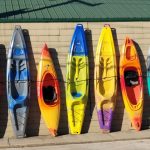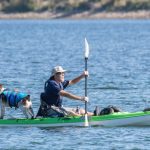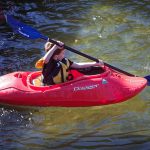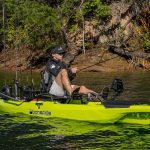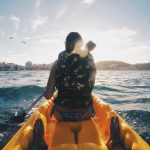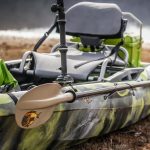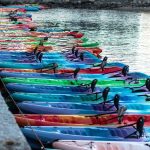This is our list of industry-leading kayak companies in the US. We also have detailed reviews of most brands and their model lines.
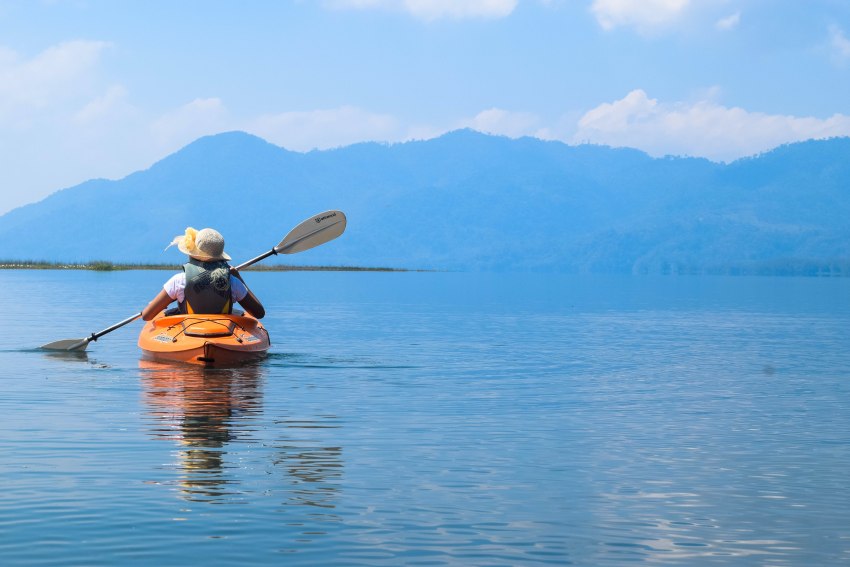
Recreational kayaks come in many forms. Many kayakers look down on recreational kayaks as being suited only for beginners, but with the wide range of models on the market, there are recreational kayaks suited to every paddler.
Sure, if you want to push the boundaries of fishing, sea kayaking, or whitewater trips, you need a specialist model, but recreational kayaks suit most paddlers.
With so many models on the market and options for fishing, camping, river trips, touring, and much more, it can be difficult to choose your perfect kayak. We have put together our list of the best recreational kayaks to make it easier for you to get on the water.
Quick Answer: Best Recreational Kayaks in 2023
- Wilderness Systems Pungo 120
- Dagger Zydeco 11
- Perception Sound 10.5
- Advanced Elements AdvancedFrame
- Crescent Ultralite
- Isle Switch 2 in 1
- Old Town Loon 126
- Wilderness Systems Pamlico
- Hobie Mirage Passport 10.5
- Eddyline Sandpiper 130
- ORU Bay ST
Comparison Table: Best Recreational Kayaks
| Model | Specs | Where To Buy |
Wilderness Systems Pungo 120 | Length: 12’2” x 29” Weight: 49 lbs Capacity: 325 lbs | Amazon |
Dagger Zydeco 11 | Length: 11’2” x 27.75” Weight: 48 lbs Capacity: 325 lbs | Amazon |
Perception Sound 10.5 | Length: 10’6″ x 29.5″ Weight: 46 lbs Capacity: 335 lbs | Amazon |
Advanced Elements AdvancedFrame | Length: 10’5” x 32″ Weight: 36 lbs Capacity: 300 lbs | Amazon |
Crescent Ultralite | Length: 10’2” x 30” Weight: 49 lbs Capacity: 350 lbs | Crescent Kayaks |
 Isle Switch 2 in 1 | Length: 11’6″ x 35.5″ Weight: 19 lbs Capacity: 425 lbs | Amazon |
Old Town Loon | Length: 12’6″ x 31″ Weight: 59 lbs Capacity: 450 lbs | Amazon |
Wilderness Systems Pamlico | Length: 13’6″ x 31″ Weight: 72 lbs Capacity: 500 lbs | Amazon |
Hobie Mirage Passport 10.5 | Length: 10’5″ x 34″ Weight: 75 lbs Capacity: 325 lbs | Amazon |
 Eddyline Sandpiper | Length: 13′ x 28″ Weight: 48 lbs Capacity: 390 lbs | Next Adventure |
 ORU Bay ST | Length: 12’3″ x 25″ Weight: 26 lbs Capacity: 300 lbs | Amazon |
Best Recreational Kayak Reviews
Wilderness Systems Pungo 120

Length: 12’2” (371 cm)
Width: 29” (74 cm)
Weight: 49 lbs (22 kg)
Capacity: 325 lbs (147 kg)
With its sturdy hull, great tracking, precision curves, and generous maximum capacity, the Wilderness Systems Pungo 120 is built for speed, comfortable all-day kayaking, and enjoyment at all skill levels.
Pungo 120 provides a comfy seat you can easily adjust in multiple ways to suit your style and size so you can hit that pro-level, in-water performance. It is a 3D foam seat with ample paddling and cushioning to keep your thighs well-supported, even on long paddles.
Even with the removable dashboard, the Pungo 120 offers plenty of room for its class. The cockpit is 57″ (147 cm) long and 22″ (56 cm) wide, which should be more than enough for most medium-sized paddlers.
Together with the comfy seat, the adjustable footrests, and soft knee padding, the Pungo 120 feels like the kind of boat you will want to have for an all-day-long adventure.
For storage, there is a sealed bulkhead in the stern, accessible via a large hatch. This not only creates a watertight storage compartment but is also a great safety feature that will prevent your kayak from sinking if you capsize. There are also some bungees on the bow and behind the seat for items you want to keep at hand while on the water.
Last but not least, the Pungo 120 offers an amazing level of speed, tracking, and stability. It is a great boat for relaxed recreational trips and all-day or even overnight adventures.
There is also a smaller model, the Pungo 105 (47 lb, 300 lb capacity), and a larger Pungo 125, which is a little heavier at 53 lbs (24 kg) but offers a respectable capacity of 425 lbs (193 kg) and a roomier cockpit.
Dagger Zydeco 11

Length: 11’2” (340 cm)
Width: 27.75” (70 cm)
Weight: 48 lb (22 kg)
Capacity: 325 lb (147 kg)
Combining all the leisure and comfort of a recreational kayak with the advanced features and control of a progressive boat, the Dagger Zydeco 11 is a great all-around choice for long days or overnight adventures on lakes and slow-moving rivers.
At 11’2” (340 cm) long, this boat is noticeably quicker than its smaller counterpart, the Zydeco 9.0. With the V-shaped hull, it tracks very well, even in choppier conditions. At just 27.75” (70 cm) wide, there could be concerns that it might be a tight fit, but the increased deck height of 15” (38cm) means there is still loads of room for you to get comfortable.
With an extra-large cockpit area and a maximum capacity of 325 lb (147 kg), the Dagger Zydeco 11 has space for an average-sized paddler and enough gear for a day trip or even an overnighter.
At 48 lb (22 kg), the Zydeco 11 is not too heavy to lift onto your car on your own.
Features include a stern bulkhead with a large hatch for dry storage and safety, a padded, adjustable seat with a high backrest, knee pads, adjustable footrests, and bungees on the deck for extra storage.
Perception Sound 10.5

Length: 10’6″ (320 cm)
Width: 29.5″ (75 cm)
Weight: 46 lb (21 kg)
Capacity: 335 lbs (152 kg)
Regardless of whether you’re a kayaking novice or an enthusiastic paddler, Perception Sound 10.5 is always a bargain. Enjoy recreational paddling and occasional fishing if you like exploring small lakes, ponds, slow-moving rivers, and calm inshore water. The Sound 10.5 is the bigger brother of the popular Perception Sound 9.5. It is suitable for heavier yakkers and is capable of carrying more gear as well.
At 10’6″ (320 cm) long and 29.5″ (75 cm) wide, this kayak isn’t too big for easy storage and transportation. It fits most standard truck beds and roof racks. With a weight of 46 lbs (21 kg), most people can easily lift and portage this boat.
The kayak can carry up to 335 lbs (152 kg) of weight, which should be enough for most average-sized paddlers. Remember that it is advisable not to load the kayak with more than 80 percent of its weight limit to get the best performance. An overloaded kayak can become slow and unstable.
The spacious cockpit measures 40.6″x21.75″ (103×55 cm) and allows comfortable entry and exit. The kayak features adjustable footrests, leg protection pads, a drink holder, and molded under-seat trays where you can put your phone or keys.
The ergonomic Zone Seat features thick padding and offers some comfort for a few hours of paddling. However, the seat base could use some extra cushioning if you plan on spending more time on the water.
The backrest is ergonomic and adjustable for height and angle, but you will appreciate an additional lumbar support pad. The padding is covered with quick-dry material, which adds to the overall comfort of the Sound 10.5.
Advanced Elements AdvancedFrame
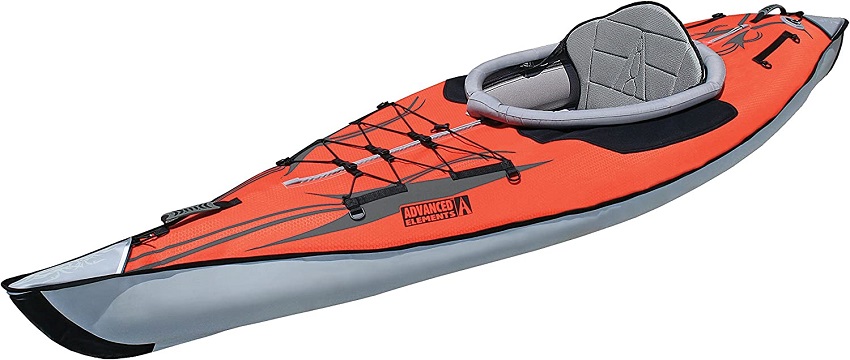
Length: 10’5” (317.5 cm)
Width: 32″ (81.3 cm)
Weight: 36 lbs (16 kg)
Capacity: 300 lbs (136 kg)
The Advanced Elements AdvancedFrame is a clever design that gives this inflatable some performance characteristics of a hardshell kayak.
Rigid aluminum ribs in the bow and stern form a sharp keel that pierces through the water, ensuring excellent speed and tracking. The reinforced 3-layer PVC material is tough as nails, while multiple air chambers improve safety on the water even if you manage to puncture the hull.
A big advantage of the AdvancedFrame is that the aluminum ribs on the bow and the stern are pre-installed so you don’t have to do any frame assembly. Just inflate the air chambers, and you’re good to go.
The AdvancedFrame delivers on its promises. It glides through the water seamlessly and can handle some wind and waves. It is stable, fast, and fun to paddle. It is also very comfortable, allowing you to stay on the water for hours.
Crescent Ultralite

Length: 10’2” (310 cm)
Width: 30” (76.2 cm)
Weight: 49 lbs (22 kg)
Capacity: 350 lbs (158.7 kg)
Crescent UltraLite is marketed as a fishing kayak but is also a great lightweight recreational boat for those that prefer sit-on-top models.
At 10’2” (310 cm) long and 30” (76.2 cm) wide, the Ultralite is pretty compact and easy to transport. It weighs 49 lbs (22.2 kg), so most people will be able to cartop it relatively easily.
The capacity of 350 lbs (158.7 kg) is more than enough for such a small boat. Together with a spacious stern tank well, it lets you take quite a lot of camping gear with you for an overnight trip. Just remember it is generally not recommended to load any kayak beyond 80 percent of its maximum capacity to achieve better performance and a drier ride.
Just remember it is generally not recommended to load any kayak beyond 80% of its maximum capacity to achieve better performance and a drier ride.
Speaking of performance, the Crescent Ultralite does not disappoint. its cleverly designed hull with a full-length keel gives you great speed without compromising stability. The kayak tracks very well but is also very agile, which makes it a great choice for creeks and small rivers.
Isle Switch 2 in 1
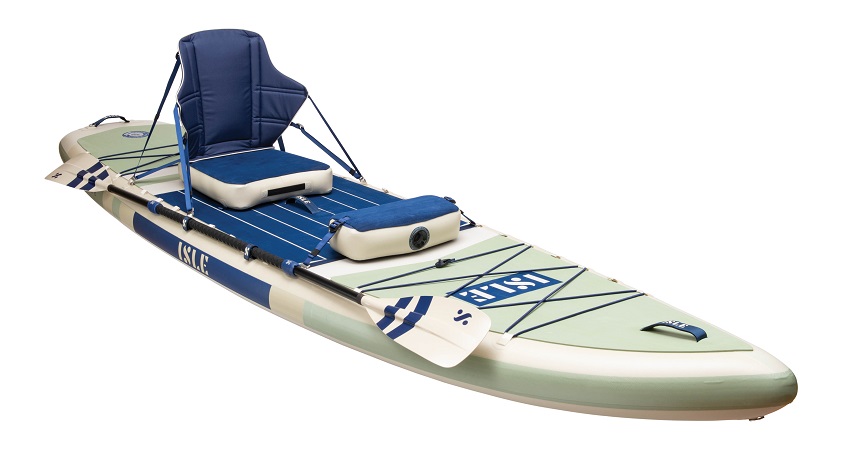
Length: 11 ft. 6 in. (3.5 m)
Width: 35.5 in. (90 cm)
Weight: 19 lbs (8.6 kg)
Capacity: 425 lbs (193 kg)
The best of both worlds in a convenient and lightweight carrying pack. The Isle Switch 2 in 1 gives you access to the world of SUP and kayaking without having to own and store two models. Even better, as a fully inflatable build, you can stow this board away in your cupboard when you’re not using it and transport it in the trunk of your car.
The Isle Switch 2-in-1 is predominantly a paddleboard. It floats on top of the water, has a large open deck design, and is complete with ample EVA deck foam for grip and stability. In fact, it’s one of the most beginner-friendly and approachable paddleboards on the market. You can hop onto this thing and take straight to the water, with most users finding they can stand up immediately.
To switch the Isle Switch 2 in 1 to kayak mode, simply attach the seat using the D-rings provided, switch the handle of the paddle for the other blade, and attach the footrest. If you’re heading out on a longer journey, you can pre-attach the seat and footrest while using the Switch 2-in-1 as a paddleboard and stow the spare paddle blade under the bow bungee, to switch on the water.
By switching into kayak mode you can generate more speed and battle against waves and wind more effectively, helping on the return leg of a journey, or against rougher weather.
Old Town Loon 126

Length: 12’6″ (3.8 m)
Width: 31″ (78.7 cm)
Weight: 59 lbs (26.8 kg)
Capacity: 450 lbs (204 kg)
The Old Town Loon is one of the best established recreational touring kayaks on the market. This kayak is designed with a more experienced recreational kayaker in mind, someone able to make full use of the narrower profile and hull shape to cover long distances and even go on multi-day recreational camping trips.
Unlike traditional touring models, the Loon retains recreational features that keep it fully accessible. The large open cockpit design prevents the feeling of entrapment that can come from a smaller deck design. It also gives the kayak the option of having the workdeck at the front. The workdeck is a recreational paddler’s dream, with on-hand storage options for cameras, phones, and snacks, as well as a USB charging port.
Perhaps the Loon’s greatest asset is the large storage capacity. The upper limit for this kayak is 450 lbs., and you can distribute this weight across the bow bungee and the stern storage hatch. The high capacity opens up opportunities to take this kayak on long day trips or overnight camping journeys.
The downside to the Loon is the weight. Compared with other recreational kayaks, you may struggle to cartop this kayak solo, with a weight of 59 lbs. On the water, it doesn’t feel this heavy, but loading it up is a challenge.
Wilderness Systems Pamlico

Length: 13’6″(4.11 m)
Width: 31″ (79 cm)
Weight: 72 lbs (32.7 kg)
Capacity: 500 lbs (249 kg)
The Wilderness Systems Pamlico is a closed-cockpit tandem kayak that has the option to convert to a solo setup when needed. This kayak is suitable for tandem pairs of all levels who want a little more protection against the elements than a sit-on-top kayak offers. By having one open cockpit rather than two smaller options, this kayak remains open and accessible and you can load up with gear, or take your dog along with you.
The seats in the Pamlico are fully adjustable, and you can even raise the front to hold you in a more comfortable position. Under the sides of the cockpit, Wilderness Systems has fitted foam padding to protect your knees from the plastic.
Now, you won’t always want to go kayaking with your partner, but you don’t need to buy a second kayak just for solo adventures. The rear seat of the Pamlico is removable, then simply rake the front seat back to a central point and you’re ready to go solo. The footrest will also move to accommodate this change.
The Pamlico is a well-rounded recreational kayak. At either end, a lengthy keel line and v-shaped hull give you tracking prowess, while the central rounded area lets you build a good amount of speed. This rounded hull may feel unstable at first, lacking primary stability, but once you get used to it this is a kayak for all recreational options.
Hobie Mirage Passport 10.5

Length: 10’5″(3.17 m)
Width: 34″ (86 cm)
Weight: 75 lbs (34 kg)
Capacity: 325 lbs (147 kg)
The Hobie Mirage Passport 10.5 is a pedal drive kayak that features the kick-up fins of the efficient Mirage drive system. Any contact with underwater obstacles kicks the fins up to avoid breaking the drive system. Despite the shorter stature of the Mirage Passport 10.5, you can still carry a reasonable speed using this drive system without over-exerting yourself.
Hobie has kept the control of your pedal-driven kayak at your fingertips, with the twist-and-stow rudder design giving you the ability to turn in tight spots. This works well with the balanced hull shape, with the v-shaped ends giving the kayak reasonable speed and tracking, while the flatter mid-section enhances the turning and balance.
The Mirage Passport 10.5 is a recreational kayak, but at its heart, it’s designed for fishing. The pedal drive lets you go hands-free and makes it easy to cast on the move. Behind the seat of the Mirage Passport, there are two rod holders, while on the sidewalls there are rails for attaching fish finders or other features.
The large capacity and storage areas give you space for crates, barrels, bags, and coolers for fishing or recreational days out.
Eddyline Sandpiper 130
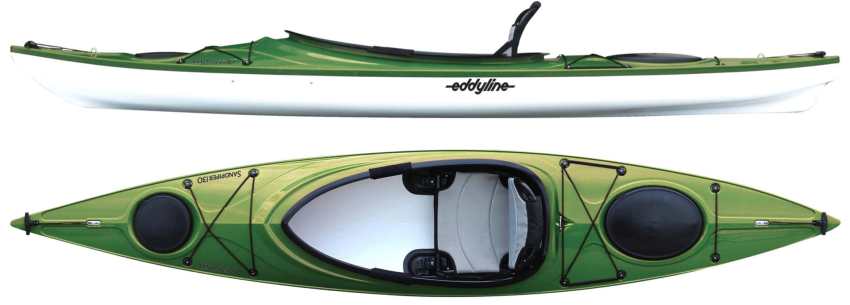
Length: 13′ (396 cm)
Width: 28″ (71 cm)
Weight: 48 lbs (21.8 kg)
Capacity: 390 lbs (176.9 kg)
Eddyline is a company renowned for making high quality ABS plastic kayaks. These kayaks have a UV resistant outer and a durable build to give you impact resistant build without the weight of a rotomolded kayak. ABS plastic gives you the feel and performance of a composite kayak, with stiffness and performance.
The Sandpiper is one of Eddyline’s recreational range, with the design centering around stability and comfort. It lacks the speed and playfulness of some higher spec models. The Sandpiper does have a reasonable keel line though, and the tracking capabilities allow you to explore some challenging water in this kayak.
Internally, the Sandpiper is relatively basic but highly comfortable and supportive. The fitted seat is high-backed and framed, supportive enough for long days out on the water. The footpegs are easily adjusted and give you reasonable support.
As well as the stability and comfort, you can throw a load of gear into this kayak. The Sandpiper has a load capacity of 390 lbs., so you can load up the internal hatches with all your overnight gear and head out on the water.
ORU Bay ST
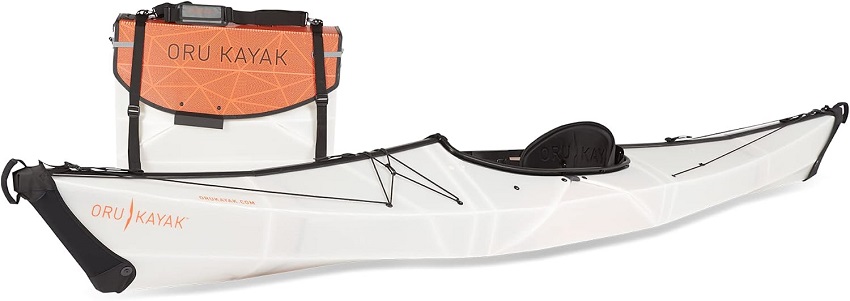
Length: 12’3″ (3.73 m)
Width: 25″ (64 cm)
Weight: 26 lbs (11.8 kg)
Capacity: 300 lbs (136 kg)
The ORU Bay ST is the ultimate in portable kayak technology. The Bay ST folds up into a package that can be carried on your shoulder and carried to the water, or packed into the hold of an airplane. Once unfolded, you can paddle the Bay ST into a kayak that can take on a whole range of recreational environments.
Although the seat inside the Bay ST is comfortable, and its fitted with a full footrest, you may struggle to get into the cockpit. Larger paddlers, who come close to the upper limit of 300 lbs., often find that the aperture is a struggle to fit through. The backrest system is also a little low for taller paddlers, but for such a small and lightweight kayak, this kayak offers a good level of comfort.
The sporty model of the Bay ST has a reasonable top speed and is playful enough for even challenging recreational environments. Thanks to the lightweight design, this picks up speed and turns at a much higher rate than most polyethylene kayaks. However, it does get blown around by the wind more than a heavier kayak and doesn’t track quite as efficiently.
How to Choose a Recreational Kayak: Factors to Consider
Recreational kayaking is one of the most popular on-the-water hobbies in the US and worldwide.
The term ‘recreational’ broadly means you want to go kayaking in an environment that is considered non-technical, such as small lakes, gentle rivers, and calm coastlines.
It’s not just for those starting out, though. Recreational kayakers range from beginners taking to the water for the first time all the way through to experienced veterans of the sport and everyone in between who want a relaxed, enjoyable kayaking experience.

Level of Experience
One of the first things to consider when you’re picking your recreational kayak is how experienced you are as a kayaker.
Kayaks for Beginners
If you are just starting out in the sport, you are going to want a kayak that prioritizes stability. These tend to be wider kayaks, usually outfitted with comfortable, supportive features.
While you’ll still be able to explore freely in these boats, you will also find it far easier to launch and land your kayak and to take a look around and enjoy the ride.
Performance-Focused Kayaks
If you have a particular focus for kayaking, then it might be worth looking into a recreational kayak that allows you to best achieve your goal.
Day touring kayaks, for example, are speed and distance-focused recreational kayaks. These often have a narrower, more v-shaped hull and will track through the water effectively over long distances. This narrower hull and more aggressive keel line can often make them feel less stable for beginners.
River kayaks, too, have sport-specific functionality. They are often designed for tighter turns and moving across flowing water, so features such as rocker, where the bow rises clear of the flow, can help you move more freely. This is almost the opposite of what you want for a day tourer.
While many beginner recreational kayaks come with comfortable, fairly open outfitting, the more technical boats can often feel far more enclosed, even the sit-on-top versions. They can have thigh straps/braces, hip pads, adjustable backrests, and footrests, all of which give you more control for technical moves such as lean-turns.
Your Ambitions as a Kayaker
These are all skills and features which may, or may not, become essential as you progress your kayaking. It all depends on your aim and your progression.
If your kayaking desires are limited to exploring a local lake or very gentle river, you may never need to consider these technical attributes. But if you want to progress your recreational kayaking to take on some faster flows (we’re not talking white water rapids here) or some long-distance journeys, consider buying a kayak that will grow with you.
Whatever the case may be, you don’t want to buy a kayak that you need to replace in a year or two!
Budget: How Much Does a Recreational Kayak Cost?
We’ve all heard the old saying; buy cheap, buy twice. With kayaks, you do get what you pay for. However, that doesn’t mean you have to break the bank, or that you should necessarily discount the kayaks on the cheaper end of the scale.
Some of the cheaper boats lack the technical features of the higher-end models, and they may be a little rougher around the edges. But if you’re looking for a quick and easy way to get out on the water in a sheltered, safe environment, you can buy a budget, beginner-friendly kayak for as little as $200.
The vast majority of recreational kayaks, though, will be somewhere in the $500 – $700 range. One of the major differences between cheaper kayaks, and these mid-priced options, will be comfort. Hulls vary enough, but spending the extra money on a kayak you can sit in all day long without a sore back, a numb butt, or tight legs, can be the difference between an okay day and a great day.
The top-end boats, those kayaks which are teetering somewhere between recreational kayaks and technical kayaks, are often more towards the $1,000 mark. The extra expense will usually result in a kayak made from lighter, stronger materials, with higher quality outfitting and a hull designed for a specific purpose.
Where You Paddle

As we said before, there are kayaks that are suitable for a whole range of environments. Before you pick your perfect kayak, look at where you want to paddle now and in the future. This will help you choose a boat that can support you in all those adventures.
Small Lakes
Small lakes are the usual stomping ground for recreational kayakers. They’re usually sheltered and the calm environment makes them a perfect place for a relaxed kayaking trip.
You can pretty much take any kayak out on these lakes, and you’ll have a great time. Just remember, if conditions get worse and you start to see small waves appearing, you might be out of your depth in your recreational kayak.
If you’re not sure, it is always a good idea to stay close to the shoreline.
Rivers
Like we said earlier, we’re not talking raging rapids here, but gentle, meandering flows without any white water.
In any river situation, you’re going to want a kayak that can turn easily so you can get back to the bank. A wide, shorter kayak is a great choice here, maximizing stability and maneuverability, rather than focusing too much on speed.
Big Lakes/Coast
These can be the trickiest environment for recreational kayaking.
On big lakes, you have to consider the effects of wind and fetch, where the wind carries waves over a long distance until they can get pretty nasty.
In coastal environments, you should be aware of the effects of the tide and waves.
Whether you want to paddle around the coast or across larger distances on lakes, a sit-in, day touring kayak is a perfect choice. Not only do these designs keep you warm, but the closed cockpit stops you from taking on too much water in the event of wind and waves.
These kayaks often have drop-down skegs or rudders that help maintain your course and track better in the wind.
If you live somewhere warm, and want to have a swim around, or try some coastal surfing, a sit-on-top is a better choice. You can climb back onto these more easily, and if you tip in the surf you can come free from the kayak immediately.
Both Lakes and Rivers
Sometimes you want the best of both worlds. If you want a kayak that can take on a bit of everything, then the sit-in or sit-on crossover kayaks will be the ideal choice for you.
These boats tend to be shorter than the day touring kayaks, allowing them to turn more easily, but they still have a slight v-shape to the hull, and often come with a drop-down skeg to help you track when you need to.
Sit-Inside or Sit-On-Top Recreational Kayak: Which Is Better?
There’s a long discussion that always surrounds whether you should buy a sit-in kayak or a sit-on-top kayak, but it does not need to be a difficult choice.
Sit-on-top kayaks
Sit-on-top kayaks are more common than sit-in kayaks in the world of recreational kayaking. The freedom they bring and the huge accessibility make them extremely appealing to beginner kayakers, as well as those with families or who want to do a bit of fishing while they’re out on the water.
These sit-on-top kayaks usually come with wide, flat hulls and are more stable, but this can compromise performance.
Sit-in Kayaks
Sit-in kayaks are the more traditional-looking boats, they sort that most people recognize instantly as a kayak.
While there are plenty of beginner sit-in kayaks on the market, they tend to come into their own on rivers, and when day-touring, where the more refined hull shapes can make a big difference to performance.
Sit-in kayaks are especially good in cold or windy areas, where the hull of the kayak keeps your legs dry and warm.
Recreational Kayak Performance
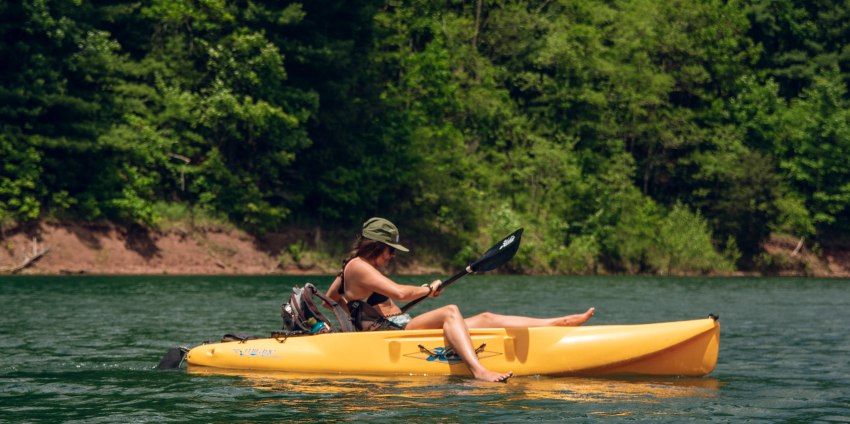
As part of our kayak reviews, we include a quick rating out of ten for each of the following, so here’s a quick rundown of what they all mean.
Remember that in kayaks with more specific purposes, like river kayaks or day trippers, these ratings are compared against similar kayaks, rather than as an overall rating. For example, a river kayak rated 9/10 for speed will be considerably slower than a day touring kayak rated 9/10.
Kayak Stability
Seems obvious, right? Stability is just how difficult it is to tip a kayak over.
There are two types of stability with a kayak; primary and secondary.
Primary stability is going to be our most common thought for a recreational kayak. This is how stable a kayak is at rest, or flat. Sit-on-top kayaks tend to have a high level of primary stability.
Secondary stability is how stable a kayak is once you lean it onto an edge. This is important for day tourers, or river kayaks, where lean turns are important.
Many kayaks prioritize either primary or secondary stability. Some have both. We usually focus more on primary stability for purely recreational kayaks but will take both into account for more technical boats.
Tracking
If you’re planning long open water trips, especially in windy places, tracking is really important for you.
Most kayaks have a keel line, of sorts. Some of these are clear and pronounced, some are softer and more rounded. A sharp keep and a v-shaped hull will help you track through the wind, which means the kayak won’t slip downwind, or spin as easily when you’re paddling into, or across the wind.
In short, it helps you go where you’re aiming. There are skegs and rudders which also help this, but most of it comes from the hull.
A sharp keel line, while making you track well, will impact how easily your boat spins and how much primary stability it will have.
Speed: How Fast Is Your Kayak?
Kayak speed depends on a number of factors, the most important being hull length and width (beam). Longer and narrower kayaks tend to be faster and require less effort to move on the water.
Maneuverability
How well does your kayak handle the twists and turns? This is mainly one for the river, really. On lakes and by the coast, it can be useful to be able to turn sharply, but more often than not you’re more concerned with going in a straight line.
Still, it’s nice to know you can turn around and head back to the shore when the time comes!
Portability
Can you lift and load your kayak on your own? Is it even possible with a friend, or will you need to get a trailer to haul your boat about? What about handles?
The lower the score, the harder it is to move your boat.
Transportation and Storage
It’s not just about weight. How easy is it to lift, move and transport your kayak to and from the water? What about storage?
Some shorter kayaks can fit inside an SUV, but anything bigger is going to need to go on a roof rack or in a truck bed. You can get truck bed extenders and kayak trailers which are great if you’re moving boats that you don’t want to lift any higher than you have to.
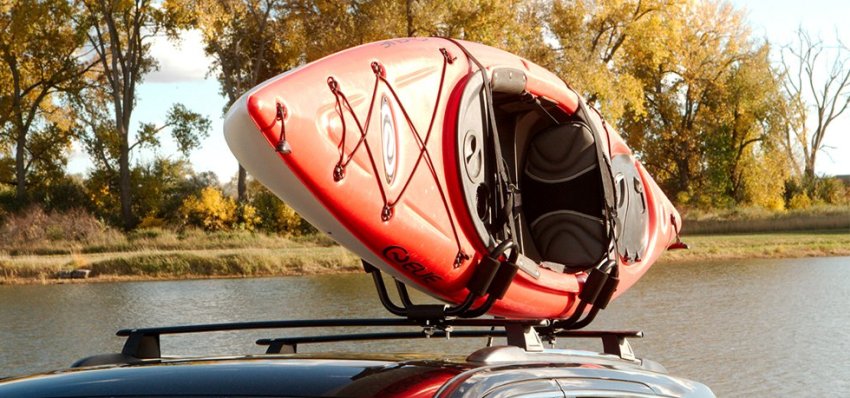
If you’re looking to load a kayak onto your rooftop, make sure that you can lift it without injuring yourself, and that your roof rack is strong enough to take the boat. Practice tying it down with straps to make sure you still have your boat when you get to the lake.
If you’re short on space, a short kayak is much easier to store and keep out of the way. Longer kayaks can be put into cradles and lifted out of the way, but only if they’re lightweight.
We have a specific kayak storage guide, but the basics are simple. Keep your kayak out of direct sunlight, and out of freezing temperatures. Don’t put any weight on your kayak, or hang it up by any stress points (like handles), or store it near any hazardous chemicals or sharp objects.
Features to Look For
Seat
Seats come in all shapes and sizes, from being molded into plastic, to highly elaborate, spinning options with adjustable backrests.
A good seat can be the difference between staying on the water for five minutes, or five hours, but don’t go overboard just because it looks fancy. Some of the best seats look incredibly basic, just make sure you have a good amount of back support.
Skeg/Fin/Rudder
These are common on day tourer kayaks and crossover boats and can take your tracking from seven to ten. By dropping a skeg or rudder down at the back of your kayak, your boat will stay in a straight line in even some of the windiest conditions.
A rudder will obviously help you make effortless turns without leaning your kayak or losing power, too.
Bulkheads
Bulkheads seal off different compartments within your kayak. Often on touring kayaks, these will separate the cockpit, where the paddler sits, from the storage hatches.
These prevent water flooding between different compartments. This doesn’t just mean your kit won’t get wet, it also means that if you have an out-of-boat experience, you have enough buoyancy in your boat that you can safely rescue yourself and carry on paddling.
Footrests
If you want to stay upright in your seat and maintain proper paddling form, footrests are a must-have. They also stop you from slumping and getting a sore back if you’re planning on spending all day out kayaking.
Footrests come in two sorts; molded or adjustable. The molded options are really straightforward and either give you a single, solid option or several recesses to choose from. These are basic, but they work.
Adjustable options give you far more finite control over exactly where your feet are. They can be fiddly to adjust and obviously are more prone to getting stuck or breaking than molded options, but in the right situation, they can be far more useful than pre-set molds.
Storage options
Sometimes when you’re out on the water, you want to take some gear with you. Whether it’s fishing equipment, a camera kit, or overnight camping stuff, you need to store it and access it.
Watertight hatches access in-hull storage, which is usually sealed with bulkheads in a closed cockpit kayak. These are brilliant for storing stuff you don’t need until you get off the water, but can be difficult to access while afloat.
Bungee and top-deck storage is a great way to access all your equipment while you’re on the water, but remember it is open to the elements, and if not properly secured, can be lost if you capsize.

